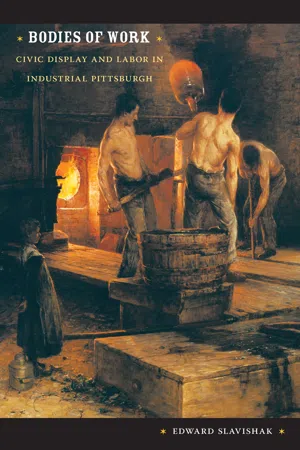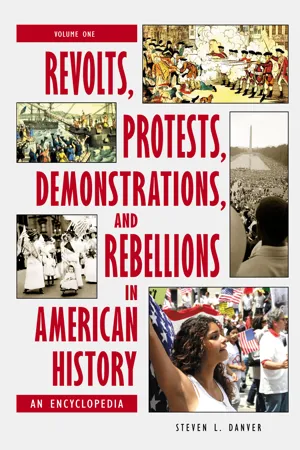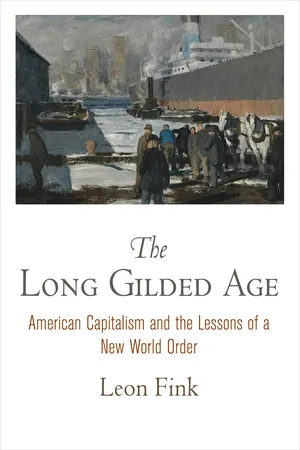History
Homestead Strike 1892
The Homestead Strike of 1892 was a major labor dispute at the Homestead Steel Works in Pennsylvania. It was sparked by a wage cut and led to a violent confrontation between the steelworkers and the Pinkerton detectives hired by the company. The strike ultimately resulted in a significant setback for the labor movement and highlighted the tensions between workers and management during the Industrial Revolution.
Written by Perlego with AI-assistance
Related key terms
1 of 5
8 Key excerpts on "Homestead Strike 1892"
- eBook - ePub
The Homestead Strike
Labor, Violence, and American Industry
- Paul Kahan(Author)
- 2014(Publication Date)
- Routledge(Publisher)
CHAPTER 3 Lead-up to the Strike P eople tend to think of the events at Homestead as a single, discrete episode in the history of American labor relations. In reality, as the last chapter demonstrated, the violence that rocked Homestead in July 1892 was the culmination of a series of changes reshaping American industry and society at the end of the nineteenth century. On the one hand (as shown in Chapter 1), individual personalities were crucial to the way events at Homestead unfolded; remove either Carnegie or Frick from the mix, and things might have turned out very differently. On the other hand, individual actors make choices in a very specific context that limits their options and makes certain outcomes likelier than others. It is crucial, therefore, to understand the context that gave rise to the events at Homestead and to see what happened there not as a single event, but rather an episode in a larger struggle between labor and industry that (as the last chapter described) had been taking place for years. The last 30 years of the nineteenth century was a period of great transition and uncertainty for business and labor alike. The United States was rocked by three recessions during this period (1873–1877, 1883–1885, and 1893–1897), resulting in extensive business failures and prolonged periods of unemployment. 1 Until the 1930s, historians called this period “the Great Depression” because the years of economic contraction actually exceeded those of expansion. This was America’s “Gilded Age,” a period of population growth and accumulation of wealth on a scale larger than at any time in American history up to that point. While the well connected could get outrageously wealthy, often their success came at the expense of millions of other people who lived on the very edge of abject poverty - eBook - PDF
From Conflict to Coalition
Profit-Sharing Institutions and the Political Economy of Trade
- Adam Dean(Author)
- 2016(Publication Date)
- Cambridge University Press(Publisher)
164 As Carnegie explained in a speech after the union victory of , “An amalgamated association has compelled us to pay one-third more ... than our great competitors pay in Pittsburgh. I know that for the success of the Homestead Works ... the present system at Homestead must be changed.” 165 158 “Peace is at Hand,” Pittsburgh Dispatch, July , . 159 “Peace is at Hand,” Pittsburgh Dispatch, July , . 160 Marcus et al. , . 161 Montgomery , . 162 Hoagland , . 163 Robinson . 164 Brody , . 165 New York Times, July , . The Gilded Wage In these ways, the Homestead lockout of ended in a tense truce, with both sides preparing for future confrontations. 166 The union sought to increase membership, but could do little to stem the tide of technological change that was gradually undercutting their structural power and weakening their bargaining power vis-à-vis their employers. As described below, the Carnegie Company set out to defeat the union by systematically overcoming every source of bargaining power that the AA used to prevail in the contest of . As one of Carnegie’s partners explained the company’s new approach to the union, “the Amalgamated placed a tax on improvements, therefore the Amalgamated had to go.” 167 And the Amalgamated would go, but only after one of the most violent labor disputes in American history would unfold in Homestead, Pennsylvania in the summer of . Homestead . The Homestead strike of has been written about at length elsewhere. 168 The July battle between the locked-out workers and Pinkerton detectives, in which at least four people were killed and more than twenty injured, received immediate recognition as a major event in American history . 169 Six days after the battle, , members of the Pennsylvania National Guard arrived in Homestead to begin a ninety-ve day military occupation that eventually allowed the company to re-open the mill with strikebreakers. - eBook - PDF
Bodies of Work
Civic Display and Labor in Industrial Pittsburgh
- Edward Slavishak, Arjun Appadurai, Jean L. Comaroff, Judith Farquhar, Arjun Appadurai, Jean L. Comaroff, Judith Farquhar(Authors)
- 2008(Publication Date)
- Duke University Press Books(Publisher)
Combined, Cornell’s dual explanations represented a striking interpretation of the meaning of Homestead, one that was echoed throughout the nation in the establishment press. The events at Homestead became the first sustained media focus on the bodies of Pittsburgh workers in the era of mechanization and mass immigration. Images of workers’ bodies at war that emanated from the coverage of Homestead raised troubling questions about the essence of Pittsburgh industry, questions that took years to address. ∞ The Homestead steel lockout claims a powerful place in the history of American labor. Historians have viewed the lockout as a contest over definitions of rights and responsibilities, a stunning setback for a domi-nant labor union, and a Gilded Age triumph of employers over workers. The historian Paul Krause has called the story of Homestead a ‘‘quasi-mythical epic’’ that became entrenched in American folklore through images of riot and bloodshed. By viewing the so-called Battle of Home-stead through contemporary written accounts that emphasized workers’ bodies in modes of spectacle, horror, and su√ering, I focus not on the event itself, but on observers’ attempts to use the event to explain such industrial by-products as demographic change and the division of labor. Although the violence at Homestead erupted quickly and unexpectedly, it did not go unseen by spectators. A plethora of journalists had descended on the mill town in the weeks before the fighting to report on the war of words between the union and the company. The result was a publish-ing frenzy that sold the story of labor strife to the city and the nation. Arthur Burgoyne’s Homestead and Myron Stowell’s ‘‘Fort Frick, ’’ both book-length accounts of the lockout published in 1893, presented them-selves as eyewitness chronicles written by local reporters who understood the essence of Pittsburgh’s industry. Burgoyne’s and Stowell’s accounts arrived relatively late, however. - eBook - PDF
Revolts, Protests, Demonstrations, and Rebellions in American History
An Encyclopedia [3 volumes]
- Steven L. Danver(Author)
- 2010(Publication Date)
- ABC-CLIO(Publisher)
The strike followed a company lockout precipitated by a failure of the union and the com- pany to come to terms on a new collective bargaining agreement. The union sought hired wages, while the company responded with a wage decrease in an attempt to break the union. The account reproduced here describes a battle between strikers and company security guards on July 6, 1892. Nothing more dramatic in the History of Labor and Capital is recorded than the Incident of the 6th of July. The forces of the Nineteenth Century are Capital and Labor, united they transform the desert into a garden, in collision they convert the garden into a waste. On the 6th of July, 1892, at Homestead, Penn., the Forces met. The sound of the shock echoed through the labor markets of the world. 634 Homestead Strike (1892–1893) In this age we regard the French Revolution with surprise, we wonder at the growth of the power of the mob, we are amazed at the brutality of the people, and we are aston- ished at the spectacle afforded by the savagery of women. The Incident of the 6th of July affords a parallel in diminutive form, and is pregnant with meaning. Let us see! A certain man, who has risen from the ranks of labor by thrift, cleverness, and lucky transactions, has amassed riches. His name is Andrew Carnegie; his fortune is written in the millions. Much of this fortune is invested in steel rolling mills at Homestead. These works cover one hundred and fifty acres of ground; here work four thousand five hun- dred men. The smoke of the flumes ascend day and night to the god of commerce, and the high price of bread consumes the day wage of the toilers. Four years ago Carnegie gave $500,000 to the campaign fund which promised him “protection” or monopoly. Fourteen competing rolling mills have passed away and one hundred acres have been added to the Carnegie plant. - eBook - PDF
The Politics of Collecting
Race and the Aestheticization of Property
- Eunsong Kim(Author)
- 2024(Publication Date)
- Duke University Press Books(Publisher)
The legacy of Homestead is the breakdown of union culture and the way in which segregated labor remains unprotected and depoliticized. The presence of Black workers in this conflict offered the possibility of trans- forming the horizon from the socialization of property to an imagination of its abolishment. The possibility. Extractive Capitalism and Wealth Transfer: The Library System, Philanthropy, and the Frick Collection After the strike, new workers were forced to sign individual contracts, and the working day increased to twelve hours. Five hundred jobs were eliminated, wages were reduced and became inconsistent, and, most im- portantly, segregated labor deployment and the breakdown of unions oc- curred throughout the United States. 72 Additionally, deunionization gave way to forms of dispossession called scientific management, which aimed to remove the “mental activity” from work once more. I will discuss the structural impact of these losses in chapter 2. And of the gains? Krause writes, “It was common knowledge that the monumental profits earned by Carnegie Steel in the 1890s grew directly from the defeat of unionism at Homestead.” 73 This point has been agreed upon across political spectrums, field emphases, and historical periods. 74 But it must be stressed repeatedly that Carnegie Steel had been wildly 48 · Chapter one profitable even before the strike. Carnegie himself was then and remained the richest man in the world, with the Carnegie Steel Company netting an average profit of $4 million ($110 million today) each year leading up to the strike, although post-strike, its excesses were rapacious—history- altering. By 1901, with J. P. Morgan’s backing, the Carnegie Steel Company became the U.S. Steel Corporation, the first global billion-dollar company ($29.664 trillion dollars today). 75 To be clear, there is no company valued at $29 trillion today. - eBook - ePub
The Long Gilded Age
American Capitalism and the Lessons of a New World Order
- Leon Fink(Author)
- 2014(Publication Date)
- University of Pennsylvania Press(Publisher)
36 Once the militia, bivouacked on company property and prepared to reopen the works at the company’s bidding, intervened, the confrontation was over.It is worth noting that unlike many other American industrial disputes, Homestead was not a case of a fatally divided or poorly led workforce. Though hierarchies of skill, ethnicity (especially Old Immigrant versus East European), and race (African Americans in significant numbers first arrived at Homestead only in the aftermath of the 1892 strike) certainly existed within both the union and local community, a remarkable cross-ethnic (and cross-gender) solidarity had held up throughout the siege. Yet, everything changed with the arrival of the militia. Chicago’s Arbeiter-Zeitung compared the situation unfavorably to Bismarck’s threatened use of force against the Ruhr miners. As a self-identified “Homesteader” rhetorically asked in its German-language pages, “What is the difference between the state’s soldiers and the Pinkertons?” 37The second (and often concurrent) resort of employers for help from the state was to the courts. In this case, Carnegie Steel’s chief counsel, Philander C. Knox, who would later serve the federal government as attorney general and secretary of state, proved a zealous litigant. As historian Paul Krause summarizes, “many of the Homestead workers, unable to raise sufficient funds for bail, were incarcerated for extended periods, and a number of those who had helped lead the sympathy strike at Duquesne also received prison sentences.” In a more controversial move, Knox collaborated with Chief Justice Edward Paxson of the Pennsylvania Supreme Court to charge thirty-three members of the Advisory Committee with no less than a charge of treason, based on a Civil War-era statute aimed at discouraging those who would attack the state. Though the treason indictments were ultimately withdrawn, the union’s resources and a good bit of its public legitimacy had been shattered by the legal onslaught. 38 - eBook - PDF
Prison Blossoms
Anarchist Voices from the American Past
- Alexander Berkman, Henry Bauer, Carl Nold, Miriam Brody, Bonnie Cleo Buettner, Miriam Brody, Bonnie Buettner(Authors)
- 2012(Publication Date)
- Belknap Press(Publisher)
2. Attentat Plans (6–22 July 1892) The 6th of July 1892 found me in Worcester, Mass., where I was work-ing as the manager of a friend’s business. I was leading a quiet, se-cluded life and had taken no active part in the anarchist movement for several months. The news of the battle in Homestead, Pa., pierced my quiet exis-tence like a bolt out of the blue. The oppression and exploitation of the Homestead workers by the Carnegie Corporation, the continu-ing systematic wage cuts, the despotism of the corporation, its exten-sive preparations—made long before the lockout—to massacre the Homestead workers, the planned strike against the life and freedom of the workers—all that enraged me against the brutal directors of the corporation. The Homestead workers’ act of self-defense was a warm ray of hope in my soul, all the more because it was not a chance, sponta-neous act, done in the heat of the moment, but a well planned and heroically accomplished defense of life and what is right. It seemed that one was dealing here with Americans—in the best sense of the word—with people in whom a spark of humanity still existed, with intelligent and resolute workers, who were not so cowardly that they would put up with every imperious, despicable act. And I was glad of it. I saw that the Homesteaders had taken a step in the right direction. Only such resolute behavior is capable of in-stilling respect—and alarm—in the oppressors. Only when they make the oppressing few feel unsafe can the oppressed many bring about an alleviation of their situation. As I said, the strikers, i.e., the locked- out workers, struck the right note by opposing force with force. It - Helene Sara Zahler(Author)
- 2019(Publication Date)
- Columbia University Press(Publisher)
In-dustrialists feared that laborers, the manufacturing hands, will leave the manufacturing districts, and go to the West, and that, in consequence of the diminution of laborers, the wages of labor will increase among them. Johnson also expressed his sympathy for workingmen who, in the old states, could never escape the iron grasp of poverty {ibid., App., pp. $19 -20, 5 3 ° ) · * Hall of Missouri and Yates of Illinois thought free farms in the West would help the Eastern worker. Henn of Iowa declared that as the earth was the gift of God, government had no right to restrict its use. He was in-structed to vote for Homestead which was not agrarian but elevating (ibid., p p . 438, 4 9 5 ) . HOMESTEAD, 1854-1862 attacked the bill, g e n e r a l l y on constitutional g r o u n d s . 5 E a s t e r n opposition s h o w e d the obverse of the labor a r g u -m e n t f o r the bill: industry w o u l d suffer f r o m the u n d u e reduction of its labor s u p p l y which this socialistic m e a s -u r e w o u l d produce. 6 O n M a y 6, 1 8 5 2 , the H o u s e finally acted on H o m e -stead. I m m e d i a t e l y , the bill w a s stripped of its l a n d -r e f o r m clauses. F i r s t to g o w a s the requirement that b e n e -ficiaries possess less than $ 5 0 0 . T h e n , o v e r M c M u l l e n ' s opposition, T h a d d e u s S t e v e n s secured the elimination of the clause f o r b i d d i n g any sale of l a n d in order to become eligible f o r H o m e s t e a d . T h e landless stipulation itself w a s 5 Southern opposition was generally based on constitutional grounds, or on resistance to the violation of the implied contract between the Federal Government and the States ceding the Northwest Territory. However, Averett of Virginia called Homestead class legislation, and Bowie of Maryland declared it a direct appeal to the venality of voters, a repetition of Rome's agrarian laws (ibid., pp. 1017-18).
Index pages curate the most relevant extracts from our library of academic textbooks. They’ve been created using an in-house natural language model (NLM), each adding context and meaning to key research topics.







